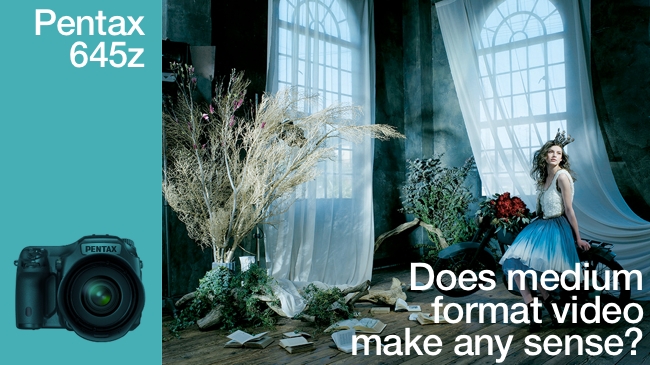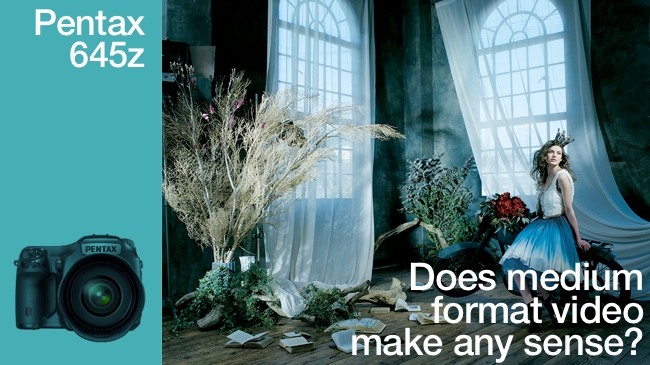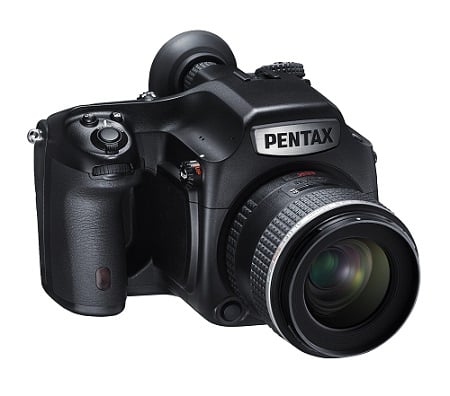
 Pentax 645z
Pentax 645z
With the release of what is probably the first affordable Medium Format digital still camera by Pentax, it makes us wonder whether Medium Format video is a thing that makes any sense
Pentax's new Medium Format digital camera, the 645z, is creating waves of excitement in the still photography community, and understandably so. It's the first digital Medium Format camera that costs anything like sensible money (if you have a limited budget). It's £6,799 excluding for the body only.
The specifications look pretty good on paper - we haven't tried one yet. If you want megapixels, it has 51.4 of them on a 43.8 x32.8mm CMOS sensor made by Sony.
I've long been intrigued by Medium Format pictures. They have a quality to them that is easily distinguishable from 35mm. There's a softness and creaminess to them that has nothing to do with sharpness and everything to do with the interplay between the foreground and the background. In addition to that, the detail is phenomenal without being clinical for when you want that softer look.
What would this mean for video?
It's hard to say. The only concrete thing you could assume is probably that, optically, your images would look more like they'd been shot on 65mm film than a smaller format. I'm no expert on this level of film making but I'm pretty sure that your video would have a distinctive and very characterful look. I'm also sure that you'll have to take extra care with your sets, your make-up and your actors' sensibilities because this will pick up and highlight every blemish.
But it will also give you the flexibility to tailor the shot as you wish. You may even wish to soften it as a creative effect.
A lot will depend on how the massive pixel count of a Medium Format camera is reduced to mere HD or 4K. If it's decimation, line-skipping or any other fairly course and unsophisticated method, the pictures may not be as good as from a dedicated video sensor with the same number of pixels as the output format. But if the full image is used to create the downscaled video, then the pictures could be stunning.
The Pentax 645z seems to defy conventional logic in that it offers a very high light sensitivity despite having a large number of pixels. Of course these are spread across a much bigger sensor than "normal" so it's not like those compact cameras with a tiny sensor a few mm across and boasting a gazillion megapixels. This type of arrangement can lead to incredibly poor noise performance as pixels compete with each other for individual photons!

The Pentax does not output 4K video as such - it can only do so in a sort of "time lapse" mode, if I've understood their marketing blurb correctly (they call it "4K interval recording". So this is not the ultimate 4K camera by any means; but it does perhaps pave the way to a full 4K Medium Format camera in future. As a fan of this size and shape of camera, I can only say that I'm excited by the prospect, although if you're going to this much trouble and expense to make video, it might be better to wait for the rumoured Alexa 65 mm camera and any others that might spring up to claim this space.
Read Ricoh Imaging's original press release after the break
RICOH IMAGING UK, LTD. is pleased to announce the launch of the PENTAX 645Z medium-format digital SLR camera. This new model features a newly designed, large CMOS image sensor with approximately 51.4 effective megapixels to deliver super-high-resolution images, all while ensuring outstanding operability and exceptional reliability to satisfy the demands of professional photographers.
The development of the PENTAX 645Z was based on the PENTAX 645D, which was launched in 2010. While retaining the proven weather-resistant, dustproof construction, it incorporates a newly developed image sensor and imaging engine to enhance image quality and reliability. It also boasts approximately 51.4 effective megapixels to produce super-high-resolution images with ‘true-to-life’ quality. It offers much-improved standard specifications, including; burst shooting at approximately three images per second; a tiltable, high-resolution LCD monitor; a state-of-the-art AF system with a live-view function; a high-precision exposure control system; and a more durable, dependable shutter unit. It also provides much faster response to the photographer’s commands in all types of shooting conditions. The result is the top level of operability and manoeuverability required in professional work. It also features full HD movie recording capability and smartphone accessibility via Wi-Fi transmission, for more flexibility and enhanced opportunities for more creative photography.
Tags: Technology


Comments